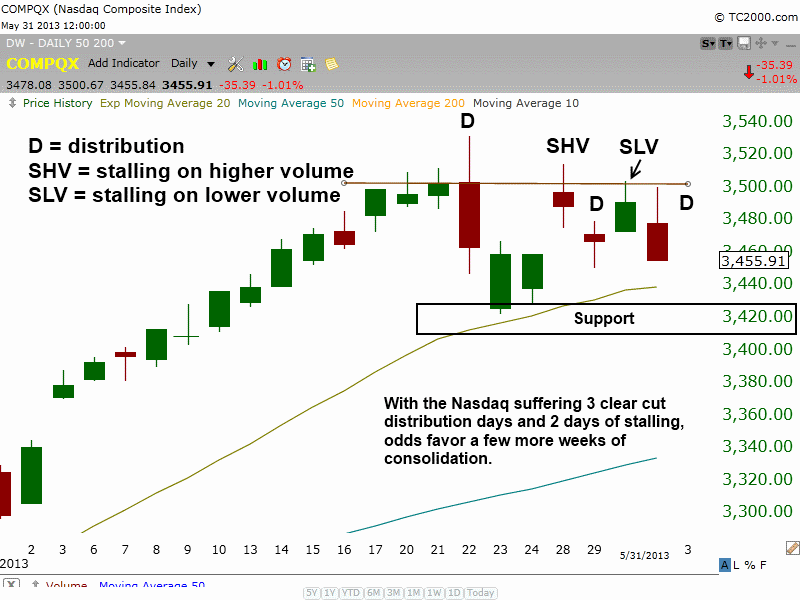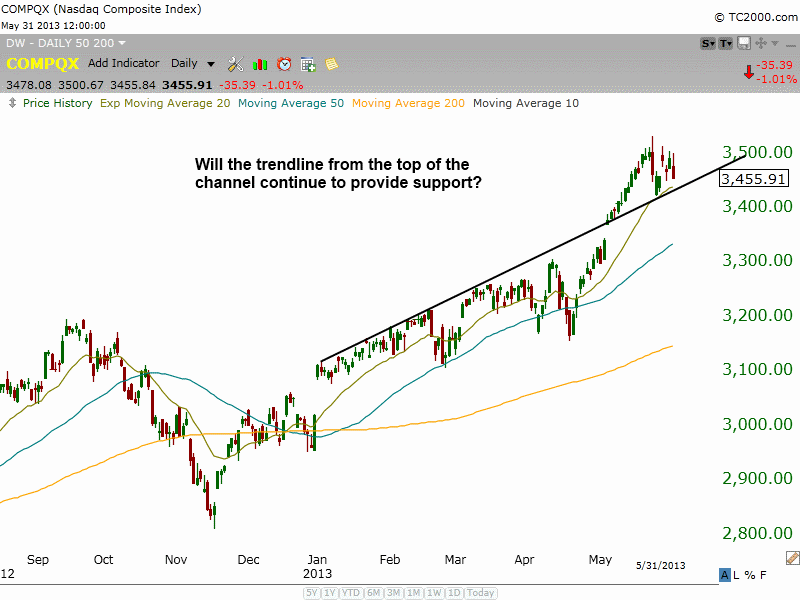After an impressive, five-month rally that was quite persistent, stocks finally took a rest and registered their largest weekly losses of the year last week. More importantly, we have started to see higher volume declines that indicate the big-money players are selling. As such, you will notice on today’s open position report that we have tightened protective stops on most of our positions in order to lock in gains and/or minimize losses in the event of further selling.
Rather than looking at individual ETF swing trade setups in today’s newsletter, most of which are not looking so hot right now, let’s take an updated look at the technical picture of the NASDAQ Composite. Since the NASDAQ showed the most leadership of the broad-based stock indexes during the most recent leg of the rally, it is the price action of this index we want to pay attention to the most.
Of all the technical indicators at our disposal, volume (and obviously price) is the most important indicator to follow. When stocks are moving higher on increasing volume, it indicates support among institutional players. Conversely, the presence of higher volume selling indicates that the “big boys” are selling. Since institutional trading accounts for more than 50% of the stock market’s average daily volume in any given day, the bias among institutional players always has a direct impact on the subsequent direction of the market.
The biggest concern in the market right now is not that stocks are pulling back from their highs, but that they are doing so on higher volume, along with several instances of “stalling” price action. The daily chart of the NASDAQ below illustrates this:

As you can see, there have been three clear-cut “distribution days” (higher volume declines), along with two days of stalling action, over the past two weeks. This has created clearly-defined resistance at the 3500 level. As such, the stock market will likely need more time to consolidate its recent gains before moving higher. Increasing day to day volatility is also a sign of a market that may be headed for at least a short-term correction.
We view stock market corrections and pullbacks as positive, healthy, and necessary unless two things happen: 1) the major stock market averages start breaking down below the 50 day moving averages 2) leading individual stocks start breaking down en masse, violating obvious levels of support.
So far, all the main stock market indexes are still firmly above their 50-day moving averages. However, the performance of leading stocks has been starting to suffer, which is a warning sign to the bulls.
Many new traders are of the assumption that trendlines need to either be clearly defined levels of support OR levels of resistance. However, this is not always the case. Sometimes, a trendline will act as the upper channel resistance of an uptrend, but then the angle of the uptrend increases, which causes that prior level of trendline resistance to become the new level of support. This is what has happened in the NASDAQ, as you can see on the daily chart below:

Despite recent weakness in the market, both the NASDAQ in small-cap Russell 2000 index are showing relative strength to the broad market by continuing to hold above their 20 day exponential moving averages. Furthermore, if the NASDAQ continues to hold above the trendline shown in the chart above, it will be very positive sign for the broad market.
Nevertheless, this is not the time to step on the gas pedal. Instead, it may be best to lock in gains on existing positions of stocks and ETFs you do not intend to hold through a pullback. Our plan is to lay low this week and see how both our Wagner Daily open positions and the broad market plays out. As in sports, sometimes playing proper defense is the best move in stock trading.
Follow us on the new FinancePins.com web site.
